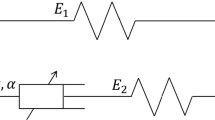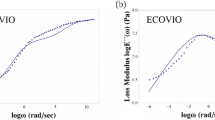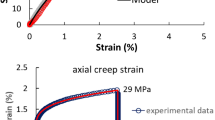Abstract
Very recently, researchers dealing with constitutive law pertinent viscoelastic materials put forward the successful idea to introduce viscoelastic laws embedded with fractional calculus, relating the stress function to a real order derivative of the strain function. The latter consideration leads to represent both, relaxation and creep functions, through a power law function. In literature there are many papers in which the best fitting of the peculiar viscoelastic functions using a fractional model is performed. However there are not present studies about best fitting of relaxation function and/or creep function of materials that exhibit a non-linear viscoelastic behavior, as polymer melts, using a fractional model. In this paper the authors propose an advanced model for capturing the non-linear trend of the shear viscosity of polymer melts as function of the shear rate. Results obtained with the fractional model are compared with those obtained using a classical model which involves classical Maxwell elements. The comparison between experimental data and the theoretical model shows a good agreement, emphasizing that fractional model is proper for studying viscoelasticity, even if the material exhibits a non-linear behavior.




Similar content being viewed by others
References
Flügge W (1967) Viscoelasticity. Blaisdell Publishing Company, Waltham
Pipkin A (1972) Lectures on viscoelasticity theory. Springer, New York
Christensen RM (1982) Theory of viscoelasticity: an introduction. Academic Press, New York
Ferry JD (1970) Viscoelastic properties of polymers. Wiley, New York
Schmidt A, Gaul L (2002) Finite element formulation of viscoelastic constitutive equations using fractional time derivatives. Nonlinear Dyn 29:37–55
Di Paola M, Failla G, Pirrotta A (2012) Stationary and non-stationary stochastic response of linear fractional viscoelastic systems. Probab Eng Mech 28:85–90
Di Paola M, Heuer R, Pirrotta A (2013) Fractional visco-elastic Euler–Bernoulli beam. Int J Solids Struct 50:3505–3510
Di Lorenzo S, Di Paola M, Pinnola FP, Pirrotta A (2014) Stochastic response of fractionally damped beams. Probab Eng Mech 35:37–43
Alotta G, Di Paola M, Pirrotta A (2014) Fractional Tajimi–Kanai model for simulating earthquake ground motion. Bull Earthq Eng (BEEE) 12:2495–2506
Pirrotta A, Cutrona S, Di Lorenzo S (2015) Fractional visco-elastic Timoshenko beam from elastic Euler–Bernoulli beam. Acta Mech 226:179–189
Pirrotta A, Cutrona S, Di Lorenzo S, Di Matteo A (2015) Fractional visco-elastic Timoshenko beam deflection via single equation. Int J Numer Meth Eng 104:869–886
Bucher C, Pirrotta A (2015) Dynamic finite element analysis of fractionally damped, structural systems in the time domain. Acta Mech 226:3977–3990
Gonsovski VL, Rossikhin YA (1973) Stress waves in a viscoelastic medium with a singular hereditary kernel. J Appl Mech Tech Phys 14:595–597
Schiessel H, Blumen A (1993) Hierarchical analogues to fractional relaxation equations. J Phys A 26:5057–5069
Stiassnie M (1973) On the application of fractional calculus on the formulation of viscoelastic models. Appl Math Model 3:300–302
Bagley RL, Torvik PJ (1979) A generalized derivative model for an elastomer damper. Shock Vib Bull 49:135–143
Bagley RL, Torvik PJ (1983) A theoretical basis for the application of fractional calculus. J Rheol 27:201–210
Bagley RL, Torvik PJ (1983) Fractional calculus: a different approach to the analysis of viscoelastically damped structures. Am Inst Aeronaut Astronaut (AIAA) J 20:741–774
Bagley RL, Torvik PJ (1986) On the fractional calculus model of viscoelastic behavior. J Rheol 30:133–155
Hilfer R (2000) Applications of fractional calculus in physics. World Scientific, Singapore
Mainardi F, Gorenflo R (2007) Time-fractional derivatives in relaxation processes: a tutorial survey. Fract Calc Appl Anal 10:269–308
Evangelatos GI, Spanos PD (2011) An accelerated newmark scheme for integrating the equation of motion of nonlinear systems comprising restoring elements governed by fractional derivatives. Recent Adv Mech 1:159–177
Failla G, Pirrotta A (2012) On the stochastic response of a fractionally-damped duffing oscillator. Commun Nonlinear Sci Numer Simul 17:5131–5142
Di Matteo A, Lo Iacono F, Navarra G, Pirrotta A (2015) Innovative modeling of tuned liquid column damper motion. Commun Nonlinear Sci Numer Simul 23:229–244
Cao L, Pu H, Li Y, Li M (2016) Time domain analysis of the weighted distributed order rheological model. Mech Time-Depend Mater. doi:10.1007/s11043-016-9314-z
Samko SG, Kilbas AA, Marichev OI (1993) Fractional integrals and derivatives. Gordon and Breach Science, Amsterdam
Podlubny I (1999) Fractional differential equations. Academic Press, New York
Nutting PG (1921) A new general law deformation. J Franklin Inst 191:678–685
Gemant A (1936) A method of analyzing experimental results obtained by elasto-viscous bodies. Physics 7:311–317
Di Paola M, Pirrotta A, Valenza A (2011) Visco-elastic behavior through fractional calculus: an easier method for best fitting experimental results. Mech Mater 43:799–806
Celauro C, Fecarotti C, Pirrotta A, Collop AC (2012) Experimental validation of a fractional model for creep/recovery testing of asphalt mixtures. Constr Build Mater 36:458–466
Fecarotti C, Celauro C, Pirrotta A (2012) Linear VISCOELAstic (LVE) behaviour of pure bitumen via fractional model. Procedia Soc Behav Sci 53:450–461
Di Paola M, Fiore V, Pinnola FP, Valenza A (2014) On the influence of the initial ramp for a correct definition of the parameters of fractional viscoelastic materials. Mech Mater 69:63–70
Cataldo E, Di Lorenzo S, Fiore V, Maurici M, Nicoletti F, Pirrotta A, Scaffaro R, Valenza A (2015) Bending test for capturing the vivid behavior of giant reeds, returned through a proper fractional visco-elastic model. Mech Mater 89:159–168
Celauro C, Fecarotti C, Pirrotta A (2015) An extension of the fractional model for construction of asphalt binder master curve. Eur J Environ Civil Eng. doi:10.1080/19648189.2015.1095685
Welch SWJ, Rorrer RAL, Duren RG (1999) Application of time-based fractional calculus methods to viscoelastic creep and stress relaxation of materials. Mech Time-Depend Mater 3:279–303
Eldred LB, Baker WP, Palazotto AN (1996) Numerical application of fractional derivative model constitutive relations for viscoelastic materials. Comput Struct 60:875–882
Pritz T (1996) Analysis of four-parameter fractional derivative model of real solid materials. J Sound Vib 195:103–115
Acierno D, La Mantia FP, Marrucci G, Titomanlio G (1976) A non-linear viscoelastic model with structure-dependent relaxation times: I—basic formulation. J Nonnewton Fluid Mech 1:125–146
Acierno D, La Mantia FP, Marrucci G, Titomanlio G (1976) A non-linear viscoelastic model with structure-dependent relaxation times: II—Comparison with L.D. polyethylene transient stress. J Nonnewton Fluid Mech 1:147–157
Green MS, Tobolsky AB (1946) A new approach to the theory of relaxing polymeric media. J Chem Phys 14:80–92
Lodge AS, Yeen-Jing Wu (1971) Constitutive equations for polymer solutions derived from the bead/spring model of Rouse and Zimm. Rheol Acta 10:539–553
Mariucci G, Titomanlio G, Sarti GC (1973) Testing of a constitutive equation for entangled networks by elongational and shear data of polymer melts. Rheol Acta 12:269–275
Meissner J (2009) Basic parameters, melt rheology, processing and end-use properties of three similar low density polyethylene samples. Pure Appl Chem 42:551–612
Meissner J (1972) Modifications of the Weissenberg rheogoniometer for measurement of transient rheological properties of molten polyethylene under shear: comparison with tensile data. Appl Polym Sci 16:2877–2899
Author information
Authors and Affiliations
Corresponding author
Rights and permissions
About this article
Cite this article
Di Lorenzo, S., Di Paola, M., La Mantia, F.P. et al. Non-linear viscoelastic behavior of polymer melts interpreted by fractional viscoelastic model. Meccanica 52, 1843–1850 (2017). https://doi.org/10.1007/s11012-016-0526-8
Received:
Accepted:
Published:
Issue Date:
DOI: https://doi.org/10.1007/s11012-016-0526-8




